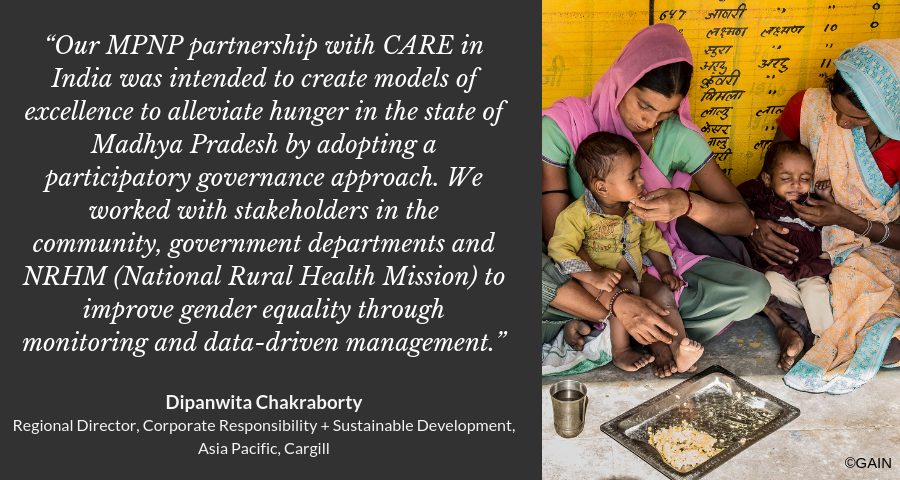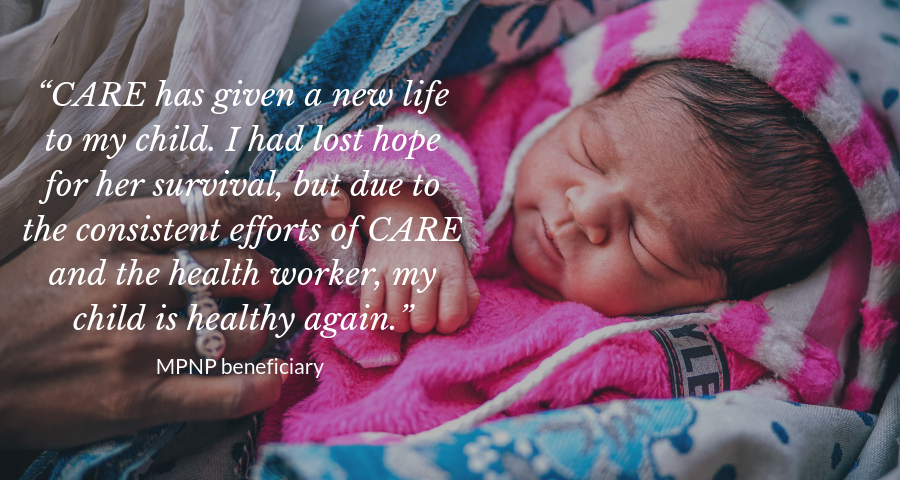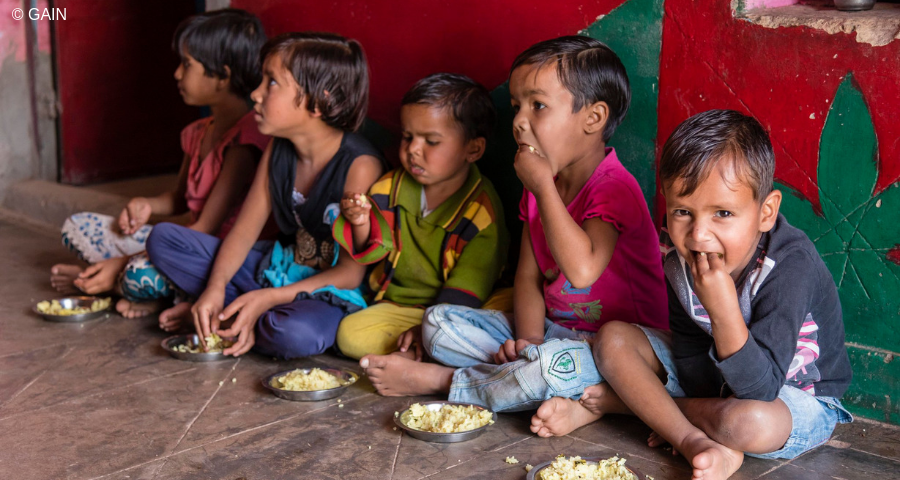About the CARE-Cargill partnership
CARE is a global humanitarian organisation providing disaster relief to areas in crisis, while providing long-term solutions to poverty around the world. They work on issues including women’s empowerment, health, food security, education, and economic development.
Cargill works across supply chains in four key areas - agriculture, animal nutrition and protein, food and financial and industrial – to connect farmers with markets, customers with ingredients, and people and animals with the food they need to thrive. By working with farmers, producers, manufacturers, retailers, governments and other organizations, Cargill strives to support communities in which it operates, helping to improve food and nutrition security, increase economic development and build resiliency.
“Together as partners, we set objectives, identify geographies to work in, monitor progress of our interventions, and determine when change is needed.”
CARE and Cargill’s global partnership goes back more than fifty years, and their portfolio of joint projects is aimed at improving food and nutrition security, increasing farmer productivity and access to markets, and building more resilient and prosperous communities.
While programs vary by country, the initiative provides training, skills-development, and market access for farmers; enhanced education and nutritional support for children; and access to social services like health care and safe drinking water for communities.
CARE and Cargill are committed to an evidence-based approach to programming – not only to maximise impact but also so the partnership can hold itself accountable to its goals and understand its impact, lessons learned, and areas needing improvement.
To learn more about the impact of the CARE-Cargill partnership, and what makes this partnership successful – including identifying strengths of each partner, setting clear goals, and promoting transparency – read the Decade of Impact report.
Background
Cargill strives to support communities in which it operates, helping to improve food and nutrition security, increase economic development and build resiliency. Cargill employs nearly 3,500 people in India, and Madhya Pradesh has the highest infant mortality rate and the third-highest maternal mortality rate among all states in India.
From 2013 to 2017, Cargill and CARE partnered together on the Madhya Pradesh Nutrition Project (MPNP) to help improve children and women’s nutritional status and save lives in three of the most challenging districts in Madhya Pradesh: Chhatarpur, Panna, and Tikamgarh.

Project leads and partners
MPNP was collaboratively led by Cargill and CARE. Partners and participants included:
- The government's Integrated Child Development Services Department
- The government’s Women and Child Development department
- Madhya Pradesh state government
- Child development programme officers (CDPOs)
- Nutrition rehabilitation centres
- Inter-Agency Group (IAG), a state forum of civil society organizations that addresses undernutrition
- Mothers, fathers, and families
- Health workers (Anganwadi centres, community-based nutrition volunteers, auxiliary nurse midwives)
- Village health, sanitation and nutrition committees (VHSNCs)
Objectives
- Reduce underweight and undernutrition among children
- Reduce severe malnutrition among children
- Expand the effectiveness, reach and visibility of undernutrition elimination efforts
- Strengthen governance, accountability and mutual responsibility of service providers and communities to foster programme success.
Overview of activities
The programme sought to achieve the above objectives through the following approaches:
- Behaviour change communication on exclusive breast feeding, complementary feeding and child and maternal nutrition
- Growth monitoring and promotion
- Increased access to and consumption of essential nutrients
- Improved access to clean water and sanitation
- Identifying, motivating and counselling families with children having severe or moderately acute malnutrition (SAM/MAM)
- Facilitating monthly meetings with mothers of SAM/MAM children
- Effective coordination and linkages with nutrition rehabilitation centres
- Use of street plays and radio to spread nutrition messages
- Community meetings with key stakeholders and
- Block-level meetings with government departments
- Strengthening village health, sanitation and nutrition committees (VHSNCs)
- Ensuring availability of health/nutrition services and supplies
- Conducting joint visits to strengthen the monitoring systems of existing government led programmes.

Outcomes
Activities aimed to build awareness, knowledge, and capacity of the community, and included:
- training nearly 1,300 frontline health workers from the government’s Integrated Child Development Services with essential skills
- organising and training 334 nutrition volunteers in 300 villages to make household visits to counsel mothers and promote exclusive breastfeeding for up to 6 months, complementary feeding practices for children ages 6-24 months, and home-based management of malnourished children
- engaging husbands and fathers in 24 villages to increase workload-sharing by men
- disseminating nutrition messages across the state through radio and television
- reaching more than 100,000 frontline health workers and government officials with mobile phone voice messages
- strengthening village health, sanitation and nutrition committees (VHSNCs)
The knowledge gained by and shared among nutrition volunteers and family members resulted in 4,688 children with severe acute malnutrition being referred to nutrition rehabilitation centers, which prevented the possible death of thousands of children. The government also agreed to open 67 new Anganwadi early childhood development centers in villages that had none.

Lessons learned
- Long-term interventions and community awareness-building is required to sustain change in individuals and households
- The nutrition volunteers had a positive impact on improving malnutrition
- Some mothers were skeptical of the nutrition rehabilitation centers, so a home-based approach may be more effective for these families
Opportunities for the future
The program has been a catalyst for new programming in the country, and the government of Madhya Pradesh continues to implement the program across the state. Government frontline workers trained through the program are still driving this work and continue to refer malnourished children to nutrition rehabilitation centers.
While the program successfully reduced undernutrition and severe acute malnutrition in the target area, more can be done, including:
- Improving coordination with other programs in target villages to deepen the intervention’s impact
- Creating greater trust between mothers and nutrition rehabilitation centers to minimize skepticism and non-supportive attitudes toward child admissions in the centers
- Closely monitoring high-burden villages with few referrals to identify populations in need
- Digital monitoring of SAM and NA cases and referrals to improve program operations and resource utilization
To scale the program, the intervention could digitize the counselling services through mobile phone or video technology, which could then allow for broadcasting video counselling in village health centers and using mobile health clinics.

Want to learn more?
The Decade of Impact report includes more information on the Madhya Pradesh Nutrition Project, as well as other CARE-Cargill projects.
The MPNP Endline evaluation provides more details on the results of this project.
Note from the editor: Nutrition Connect aims to share examples of partnerships and collaborations that result in positive nutrition outcomes. We seek examples that objectively demonstrate the potential of public private engagement, in particularly those which are underpinned by sound methodology, including evaluation. However, Nutrition Connect and its funders do not endorse any specific company, government or partnership, and in all cases a single example may not reflect the institution’s overall impact on food and nutrition security. For more information, the Editorial approach sets out our policy for content management, including case studies. Any related queries should be sent to nutritionconnect@gainhealth.org.